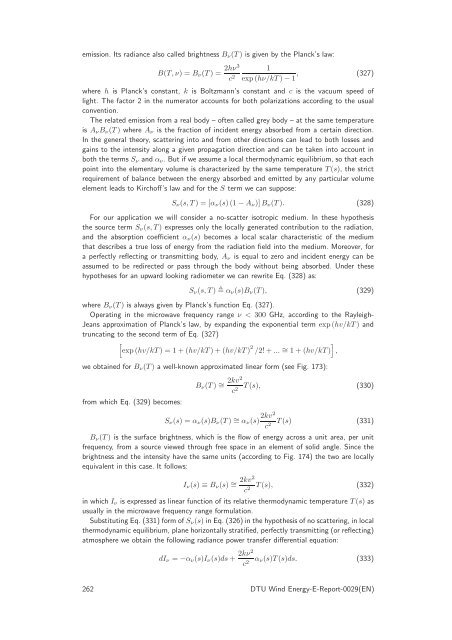Publishers version - DTU Orbit
Publishers version - DTU Orbit
Publishers version - DTU Orbit
Create successful ePaper yourself
Turn your PDF publications into a flip-book with our unique Google optimized e-Paper software.
emission. Its radiance also called brightness Bν(T) is given by the Planck’s law:<br />
B(T,ν) = Bν(T) = 2hν3<br />
c 2<br />
1<br />
, (327)<br />
exp(hν/kT)−1<br />
where h is Planck’s constant, k is Boltzmann’s constant and c is the vacuum speed of<br />
light. The factor 2 in the numerator accounts for both polarizations according to the usual<br />
convention.<br />
The related emission from a real body – often called grey body – at the same temperature<br />
is AνBν(T) where Aν is the fraction of incident energy absorbed from a certain direction.<br />
In the general theory, scattering into and from other directions can lead to both losses and<br />
gains to the intensity along a given propagation direction and can be taken into account in<br />
both the terms Sν and αν. But if we assume a local thermodynamic equilibrium, so that each<br />
point into the elementary volume is characterized by the same temperature T(s), the strict<br />
requirement of balance between the energy absorbed and emitted by any particular volume<br />
element leads to Kirchoff’s law and for the S term we can suppose:<br />
Sν(s,T) = [αν(s)(1−Aν)]Bν(T). (328)<br />
For our application we will consider a no-scatter isotropic medium. In these hypothesis<br />
the source term Sν(s,T) expresses only the locally generated contribution to the radiation,<br />
and the absorption coefficient αν(s) becomes a local scalar characteristic of the medium<br />
that describes a true loss of energy from the radiation field into the medium. Moreover, for<br />
a perfectly reflecting or transmitting body, Aν is equal to zero and incident energy can be<br />
assumed to be redirected or pass through the body without being absorbed. Under these<br />
hypotheses for an upward looking radiometer we can rewrite Eq. (328) as:<br />
Sν(s,T) αν(s)Bν(T), (329)<br />
where Bν(T) is always given by Planck’s function Eq. (327).<br />
Operating in the microwave frequency range ν < 300 GHz, according to the Rayleigh-<br />
Jeans approximation of Planck’s law, by expanding the exponential term exp(hv/kT) and<br />
truncating to the second term of Eq. (327)<br />
<br />
exp(hv/kT) = 1+(hv/kT)+(hv/kT) 2 /2!+... ∼ <br />
= 1+(hv/kT) ,<br />
we obtained for Bν(T) a well-known approximated linear form (see Fig. 173):<br />
from which Eq. (329) becomes:<br />
Bν(T) ∼ = 2kv2<br />
T(s), (330)<br />
c2 Sν(s) = αν(s)Bν(T) ∼ = αν(s) 2kv2<br />
T(s) (331)<br />
c2 Bν(T) is the surface brightness, which is the flow of energy across a unit area, per unit<br />
frequency, from a source viewed through free space in an element of solid angle. Since the<br />
brightness and the intensity have the same units (according to Fig. 174) the two are locally<br />
equivalent in this case. It follows:<br />
Iν(s) ≡ Bν(s) ∼ = 2kv2<br />
T(s), (332)<br />
c2 in which Iν is expressed as linear function of its relative thermodynamic temperature T(s) as<br />
usually in the microwave frequency range formulation.<br />
SubstitutingEq. (331)formofSν(s) in Eq.(326)inthe hypothesisofnoscattering,in local<br />
thermodynamic equilibrium, plane horizontallystratified, perfectly transmitting (or reflecting)<br />
atmosphere we obtain the following radiance power transfer differential equation:<br />
dIν = −αν(s)Iν(s)ds+ 2kν2<br />
c 2 αν(s)T(s)ds. (333)<br />
262 <strong>DTU</strong> Wind Energy-E-Report-0029(EN)

















